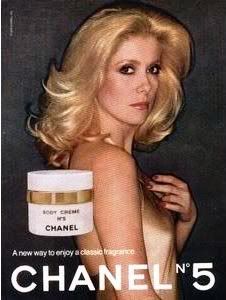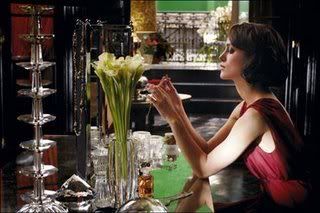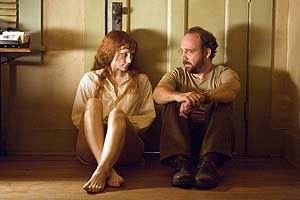The issue of perfume advertisements arises from time to time, with mixed results. Usually it has to do with the shock value of something or the sheer ingenuity of advertisers who come up with catchy phrases and images to embed an idea in our minds for ever. Although print ads have their merits and I will devote entries on them in the future, I think it has been already done so I have been trying to expand into the
multimedia world of TV and theater commercials. In the interest of accomplishing that I have compiled a great annex of commercials on my main info site,
Perfume Shrine and it will appear soon on-line (patience!). But first I wanted to discuss the matter here, so the next few entries will be devoted to the analysis of perfume advertising with the provision of commercial clips. I have of course decided to edit and not present all the clips; I just chose the most memorable ones and those which serve the purpose of illustrating my points.
Perfume commercials and their study shows the evolution not only of the deviousness in advertising or the images that capture each generation’s fantasy, but also the emergence of different aesthetic values based on the zeitgeist and the artistic contribution of celebrated individuals in their respective fields. This aspect is fascinating, aggrandizing the subconscious and examining how tastes differ between various cultures. Naturally, the sources of perfume advertising stem from two main sources, the US and Europe, so the contrasting and comparing is in most cases done between the two. Contemplating the schism between the two cultures over years of advertising, one realises that it is not that great after all, at least in this particular field, since people have been influenced by one another. Of course there are also examples of marked differences both in cultural sensitivities and in chronological advancement, especially since the AIDS epidemic which almost eliminated public displays of eroticism in the media, as well as the trend for “clean” perfumes and the newly fanged “celebrity perfume” which influenced advertising on its own by grafting the center of the commercial from the fantastical and fictional to the famous individual who represents a specific association already in the consumer’s mind. Nevertheless, each commercial stands on its own and has its merits and its flaws.
The first series of clips I was interested in exploring was Chanel’s for her iconic Chanel #5 perfume. It is a prime example that exhibits the evolution of aesthetics and advertising admirably, while all the while transpiring the message of a perfume imbued in fantasy, rather than reality. Chanel #5has always been a miracle of marketing. From the tales of Coco Chanel herself who supposedly sprayed the perfume in theaters and shops to garner attention and public awareness and who also gave small batches to her most exclusive clients, this perfume has stood the test of time not only on the merits of its mesmerizing jus, but also because the choice of bottle, packaging, colour coordination and overall presentation has been impeccable over the years. The first clip I found on this one comes from a UK ad in 1970. ] Watch it clicking here A haphazard meeting of a man and a woman in an art gallery. From the quite awkward event, characters dressed in the wide pants of the era (and yes, the lady is wearing them as well, as a symbol of emancipation) to the makeup and the stylized coif, the images progress in a cinematic flash back of the lady preparing for her day carelessly applying some Chanel #5 while chatting on the phone, her Afgan dog on the white sofa that matches her outfit; while at the end, it’s Chanel #5 that has provided the trigger for the romantic tête-à-tête in the sunset, when the lady is wearing a gown (so we know romantic time is coming) and her hair in an updo. The notion behind it is devious in that it insinuates that Chanel#5 is both sophisticated enough for an art gallery setting for a modern smart lady of means but also for more intimate moments.
Next comes the classic image provided by the artistry of british director Ridley Scott in 1979. The whole concept is exquisite: the woman is lying on the pool, with a seductive and dreamy voice-over: “I am made of blue sky and golden light and I will feel this way for ever”. The image of the airplane soaring in the blue sky, casting the shadow of a shark in the pool momentarily and then the man across swimming to her, aggresively one might say, while she languorously drinks up the sunshine, bronzed and made-up vividly in red and grey blue, has been embedded to the subconscious of anyone involved in perfume; even Chandler Burr's who used this image for another perfume review recently in his column. This proves the artistry and cunning of the concept. “Share the fantasy” the tagline ends and it is indeed a fantasy that transpires through watching the clip. Chanel #5 is again the perfume of indulgence and luxury (private pools being a scarce commodity back then), the escape to other worlds for people in the UK and colder climates, who dreamed to be in a tropical paradise and yearned for a setting of this kindWatch the clip clicking here
The next clip in the chronological series is also made by Ridley Scott, in 1980, who here again uses the elements of the luxuriant vacation spot, the blue waters and the sparseness of composition. All the while the old song “Sea of love” plays in the background. Carole Bouquet, then face of Chanel #5, is decked out in classic austere black, with a wide rim straw hat, also black, and a black one-piece swimsuit. Très chic in her red lipstic, an exclamation point on the white canvas of her skin and an invitation to sexuality. A close-up on her shoes reveals the brand name Chanel, while her white earrings also bear the logo of the brand, so as the viewer never mixes this up with anything else. The setting seems to be a private house in Cote d’Azur or Capri, all Mediterranean colours (of which Scott is very fond of, for those who know). A well suited man comes down a boat (which is odd, but maybe we could bypass it, as it might want to convey an image of authority and financial power) and as Carole leans back her big hat providing an exquisite “cadre” for the shot, they kiss. It’s only at the last shot that we realize that the pool is also shaped in the shape of Chanel #5 bottle. The exact same tagline of “Share the fantasy” (spoken in the french accents of Carole) finds its master in this admirable clip. Watch the clip clicking here
Following is a clip from the French director Luc Besson and eerie, wonderful music by Danny Elfman (Tim Burton’s sidekick, if that tells you anything; this is from the film Edward Scissorhands). This one is actually my favourite of all the Chanel #5commercials to date, if only because it brilliantly plays on the Little Red Riding Hood tale and the eroticism and naughtiness associated with it psychologically. Estella Warren dressed up in red and shoed in red dancing shoes enters playfully and mock-innocently the big vault where #5 is kept, the walls all quilted as a nod to the famous Chanel bags; from the plethora of bottles she picks one, lovingly holding it for a sec and luxuriously applies some drops on her neck. Picks up the bottle and places it in her straw basket lined in plaid cloth, to further drive in the point of the tale; while the unmistakable form of a wolf comes from the corridors following the thief Estelle, who finally dons her red cape and hood and opens the vault to the great city that lies beyond, Paris, the Tour d’Eiffel on the background, majestic, lighted up in the night. She makes an authoritative gesture to shush the wolf, who obeys, undoubtedly enslaved by the magical feminine fumes emanating from her. She goes out into Paris, the great unknown, city of wonder, ready for a greater adventure, while the male wolf is wailing into the night. Watch the clip cliking here What a masterpiece, what use of imagination….I am trully enslaved. I actually bought again some Chanel #5 after this, I have to admit. This is the power of advertisement. It not only lures you to consider something as desirable and necessary when it might not be; it can be so cunning as to make you buy something as an endorsement to the great sense of style the brand possesses, as if you become a conspirator, an accomplish to a tale of mystery and naughtiness. Ah…these are the great ones! There is another splendid version of the tale, again by Besson, but I have kept that one on my extensive list for further viewing, for those interested.
The latest commercial for Chanel#5 is testament to both what great filmmaking can do and what the limitations of fantasy might be. Directed by aussie director Baz Lurhman, starring Nicole Kidman as the undisputed protagonist of our collective consiousness, decked from head to toe in Karl Lagerfeld couture for Chanel, and brilliantly set to the completely magical score of Clair de Lune by Debussy, it runs a whole two minutes and looks more like a regular film than a perfume commercial, earning it the tagline of costliest commercial to date. I won’t try to recount the plot here, as it would spoil the climax, suggice to say that Nicole plays the role of a dancer who disappeared and is chased by the paparazzi, meeting an unsuspecting dashing male in the taxi she enters to escape them.Watch the clip clicking here Everything in the film speaks of romance, memories, the imprint of an ill-fated love affair, the luxury and grandeur of someone who is obviously at the top of the world, as is indeed the building on which Nicole and her lover consummate their affair. Everything has to do with catching the moment and making it last for an eternity and this particular angle is not only prime for catching an advertiser’s eye but also the consumer’s who wishes to impart lasting impressions via the most ephemeral of adornments, perfume. In a nutshell the dream of immortality, if only in the memory of a loved one. However this commercial, when contrasted with the previous one, shows a lack of naughtiness (despite the effort on Nicole’s part to convey it with her body language and face expressions on occasion) and less imagination applied, because the situations although majestic and in the sphere of the super-famous do seem tangible and rooted in reality. This I think is the only "flaw" (if one might be so bold as to use such a term) of this last commercial and the reason it is not my absolute favourite in the Chanel #5 series; nevertheless it is always a joy to watch and not to be missed.
Next I go on to critique more controversial stuff sure to elicit response. Stay tuned.
.jpg) The film commercial for No.5 with Tautou has been a resounding success ( Watch it here if you haven't yet). Can the new print ad compete with the previous representations? It all depends...
The film commercial for No.5 with Tautou has been a resounding success ( Watch it here if you haven't yet). Can the new print ad compete with the previous representations? It all depends... The focal point in La double vie de Veronique was the existential question of free will or fate. Without resorting to such elaborate and antithetical to the premise of luxurious abandon that perfume should evoke, isn't Chanel No.5 winking at us through its commercials and advertisments, as well as their egeries, that there is a reason behind every choice we make and the choice has but one name, that of Chanel?
The focal point in La double vie de Veronique was the existential question of free will or fate. Without resorting to such elaborate and antithetical to the premise of luxurious abandon that perfume should evoke, isn't Chanel No.5 winking at us through its commercials and advertisments, as well as their egeries, that there is a reason behind every choice we make and the choice has but one name, that of Chanel?.jpg)





.jpg)






.jpg)
.jpg)

.jpg)










.jpg)
